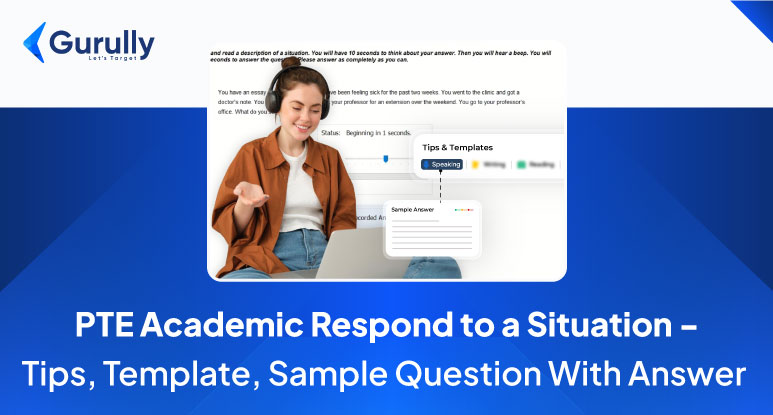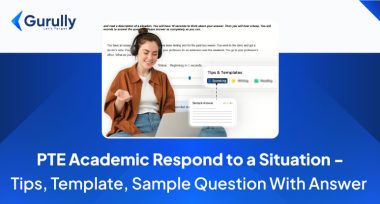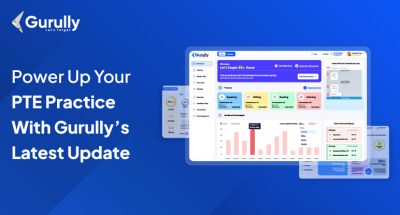Pearson test of English has recently added the Respond to a Situation task in PTE Academic. Initially, this task was only in PTE core, but with the latest changes effective from 7th August 2025, this task will also be seen in PTE Academic. In this task, your content, pronunciation, and oral fluency skills will be evaluated. But if you are wondering what is different in PTE Respond to a Situation of an academic exam, then here is the guide.
Know the format, tips, template, and sample question with answers for PTE Academic Respond to a Situation.
What is “PTE Respond to a Situation”
In this task, you will listen and read a prompt in which there will be a description of a situation. To answer the task, you have to speak, what you would say in the situation. You will have 10 seconds to prepare and 40 seconds to speak
| Prompt Length | Skills Assessed | No. of Questions | Traits Scored |
| Text up to 60 words | Speaking | 2-4 | Content, Oral Fluency & Pronunciation |
Scoring :
Scoring in PTE Respond to a Situation (Academic) is done on basis of following traits:
Content:
| Score | What It Means |
| 6 | Fully answers the situation. Response is clear, detailed, and persuasive. Goes beyond the prompt naturally. |
| 5 | Mostly clear and correct. Handles the situation well with just minor issues. Uses a good range of language. |
| 4 | Answers the situation okay, but with some small mistakes. Language is mostly appropriate. |
| 3 | Barely answers the basic point of the situation. Limited vocabulary or mistakes in usage. |
| 2 | Tries to respond but misses the main point or misunderstands the situation. Lots of errors or copied prompt words. |
| 1 | Doesn’t understand the situation. Very limited response, repeats words from the prompt without context. |
| 0 | Too short or unclear to score properly. |
Pronunciation:
| Score | Level | Explanation |
| 5 | Highly Proficient | Sounds natural and easy to understand. |
| 4 | Advanced | Minor accent but still clear. |
| 3 | Good | Understandable with some effort. |
| 2 | Intermediate | Noticeable pronunciation issues. |
| 1 | Intrusive | Hard to understand. Sounds unnatural. |
| 0 | Non-English | Doesn’t sound like English or not understandable at all. |
Oral Fluency:
| Score | Level | Explanation |
| 5 | Highly Proficient | Speaks smoothly with good rhythm and no hesitation. |
| 4 | Advanced | Mostly fluent with minor pauses. |
| 3 | Good | Some pauses or uneven flow, but okay overall. |
| 2 | Intermediate | Breaks in speech, noticeable hesitation. |
| 1 | Limited | Very slow or broken speech. |
| 0 | Disfluent | Disconnected, hard to follow, or unnatural speech. |
PTE Respond to a Situation Template:
Introduction (Context and Purpose)
- I am responding to the situation related to [briefly mention the academic issue, e.g., a missed lecture, group work, assignment, etc.].
Explanation (What Happened and Why)
- Due to [brief reason, e.g., personal health issues, scheduling conflict], I was unable to [mention the academic responsibility, e.g., attend the session, submit the task].
Acknowledgement (Show Responsibility)
- I understand this may have impacted [the team, schedule, or academic expectations], and I sincerely regret the inconvenience caused.
Action or Request (Solution-Oriented Approach)
- To address this, I would like to [propose a solution or make a request, e.g., access the materials, reschedule the meeting, or seek clarification].
Closing (Gratitude + Willingness to Improve)
- Thank you for your understanding. I will make sure to manage my responsibilities more effectively moving forward.
PTE Academic Respond To Situation Tips:
Get Familiar with Common University Scenarios
The first thing to understand is that these aren’t random situations. They’re modelled after real events from campus life. You might be asked to:
- Explain why you missed a class or group meeting
- Request help from your professor or a librarian
- Give feedback to a classmate
- Apologize for a delay or miscommunication
When you know the types of situations that can appear, it’s much easier to prepare.
Use the Right Kind of Language
In academic environments, your language should be polite and appropriate. Learn a few helpful expressions like:
- “I’d like to request…”
- “I apologise for the inconvenience…”
- “Could you please clarify…”
- “I understand the importance of…”
Use Your Preparation Time Wisely
The preparation time is only 10 seconds, so use it wisely. In the preparation time, think quickly about:
- What is happening or has happened?
- Whom are you talking to?
- What needs to say?
Try to stick to main points and do not try to explain everything in detail.
Change Your Tone According To the Situation
If the situation is related to speaking to a professor or university officials, make sure to use a formal tone. If the situation demands speaking to classmates, your tone can be casual. Try to shift your tone on the demand of situation given, as it will reflect good oral fluency.
Think in Terms of Problem → Impact → Solution
This approach helps you stay focused and logical. Here’s how it works:
- What was the issue? (e.g., You missed a group meeting)
- What was the result? (e.g., Your part of the work was delayed)
- What are you doing now? (e.g., You’re offering to submit your part today)
- This simple flow makes your response feel complete and responsible.
Use Linking Words to Organise Your Thoughts
To keep your speech smooth, use linking phrases like:
- “Unfortunately…”
- “As a result…”
- “However…”
- “Therefore…”
- “To summarise…”
Using linking words while speaking about the situation will help in framing a well-structured response.
Avoid These Mistakes:
While describing the situation, do not:
- Repeat same sentence twice.
- Speak off-topic.
- Use indefinite phrases like “It was bad” or “I had a problem”, etc.
- Use informal slangs or abbreviations, i.e. “gonna” or “wanna”
Practice With Mock Test to Increase Confidence:
To score high in PTE respond to situation practice on Gurully’s PTE Academic Mock test. These mock tests will help in understanding the format of the question properly. By practicing on free question-wise practice, you will be able to understand where you are lacking and how to strengthen that.
PTE Academic Respond to a Situation Sample Questions With Answers
Audio 1 :
Answer :
Hi Dr. Singh, thank you so much for inviting me to contribute a section to the collaborative research paper. I’m really eager to participate and excited about the opportunity. Before I confirm my involvement, could you please share more details about the preferred length for my section, the referencing style we’ll be using, and the final submission deadline? Knowing this information will help me plan my work effectively and ensure my contribution aligns with the team’s standards. I’d love to get started as soon as I have these details.
Audio 2 :
Answer :
Hi everyone! I saw the proposed time for our meeting to discuss the class presentation, but unfortunately, it overlaps with one of my other classes. I really don’t want to miss out on contributing to our preparation and sharing ideas. Could we consider rescheduling to a time that works for everyone? Maybe we could each suggest a few alternative time slots and choose one that suits most people. That way, we can have a productive discussion without anyone having to miss out.
Audio 3 :
Answer :
Hi team! I’m happy to take charge of designing the poster for our upcoming conference presentation. To make sure I can complete the layout on time, I’ll need everyone to finalize the text content and send me any relevant images by Thursday. Having all the materials early will allow me to create a clear and professional design and also leave time for any edits or feedback from the group. Can we agree on this timeline so everything is ready before the deadline? I’m confident we’ll create a great poster together.
Audio 4:
Answer :
Hi Dr. Patel, I’m honored to be considered for co-authoring the academic journal article with you and Dr. Kumar. Before I confirm my participation, could you please clarify my role in the project, the expected workload, and how the tasks will be divided among us? Knowing these details will help me manage my schedule and ensure I can contribute effectively without overcommitting. I’m very excited about this opportunity and would like to plan my involvement properly. Thank you for considering me for this collaboration.
Audio 5 :
Answer :
Hi Jessica, I’d be happy to help with decorating for the academic fair and support the team in any way I can. Before I confirm, could you please let me know the exact date, time, and location for the setup? This will help me plan my schedule and make sure I can commit fully without any clashes with other responsibilities. I’d also like to check if there are any specific decoration themes or materials we’ll be working with so I can prepare accordingly.
To help you achieve a high score, practice these questions for free on Gurully. Our full-length mock tests are designed by experts following the updated PTE format. You can make use of section-wise tests to sharpen your preparation. Our platform provides real-time exam simulation to build your confidence.
Conclusion:
The addition of the Respond to a Situation task in PTE Academic reflects Pearson’s aim to evaluate practical communication in academic settings. While it may seem new, with the right strategies—like understanding the format, adapting your tone, and thinking in a structured way—you can handle it confidently.
Focus on clarity, relevance, and fluency while avoiding common mistakes. Most importantly, regular practice through reliable platforms like Gurully will help you build the skills needed to perform well. The more familiar you are with real-time scenarios, the better your chances of scoring high.
FAQ:
What is Respond to a Situation in PTE Academic?
Is it easy to score 70 in PTE?
Is it easy to get 79 each in PTE?
Which part of the PTE is difficult?
What if I fail the PTE?
Also Read:
- PTE Summarize Group Discussion – Expert Tips, Template & Sample Question With Answers
- New PTE Update 2025: Pearson Adds Two New Tasks to the Exam
- PTE Academic Describe Image: Tips, Types, and Sample Question with Answers







